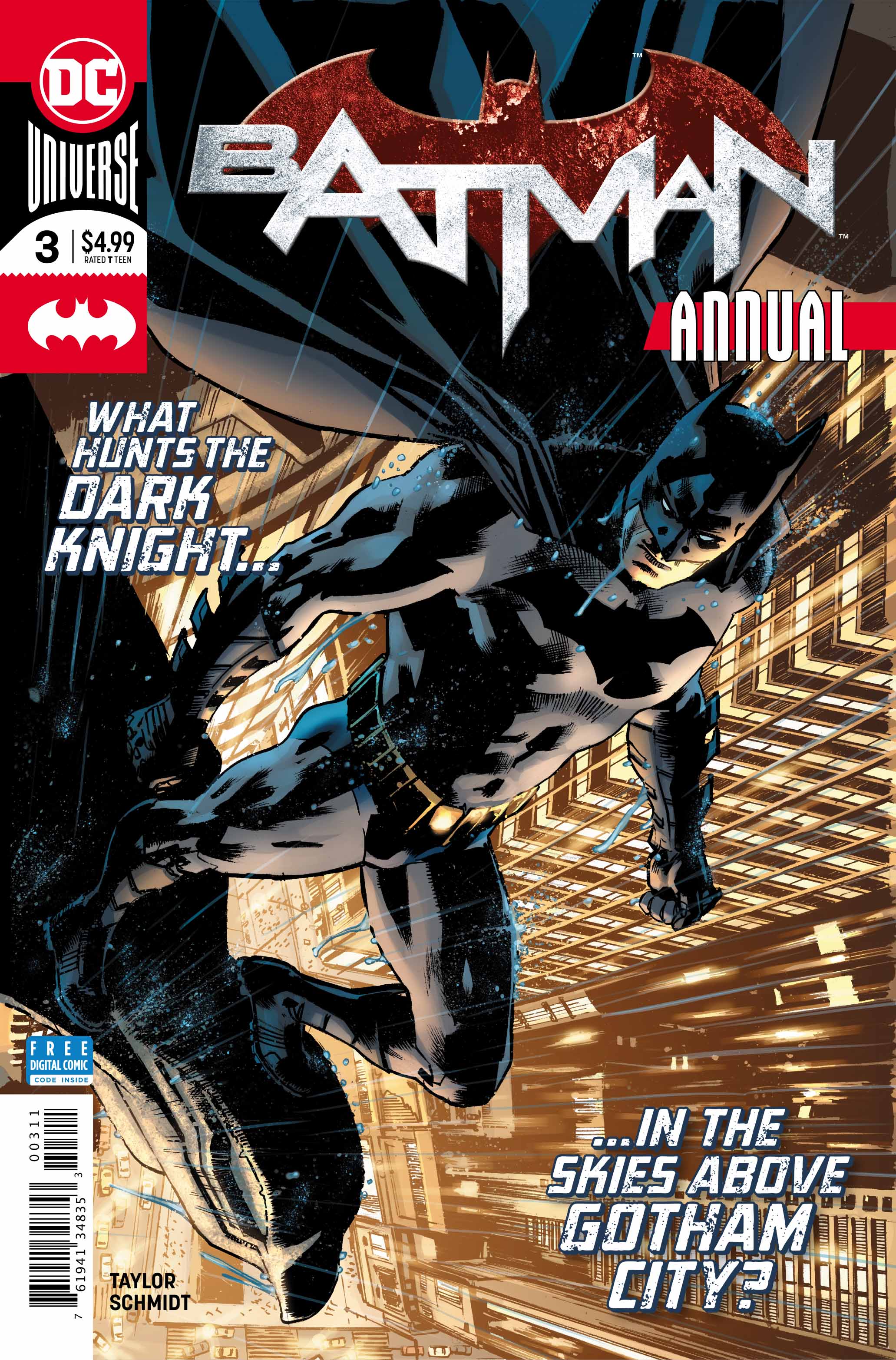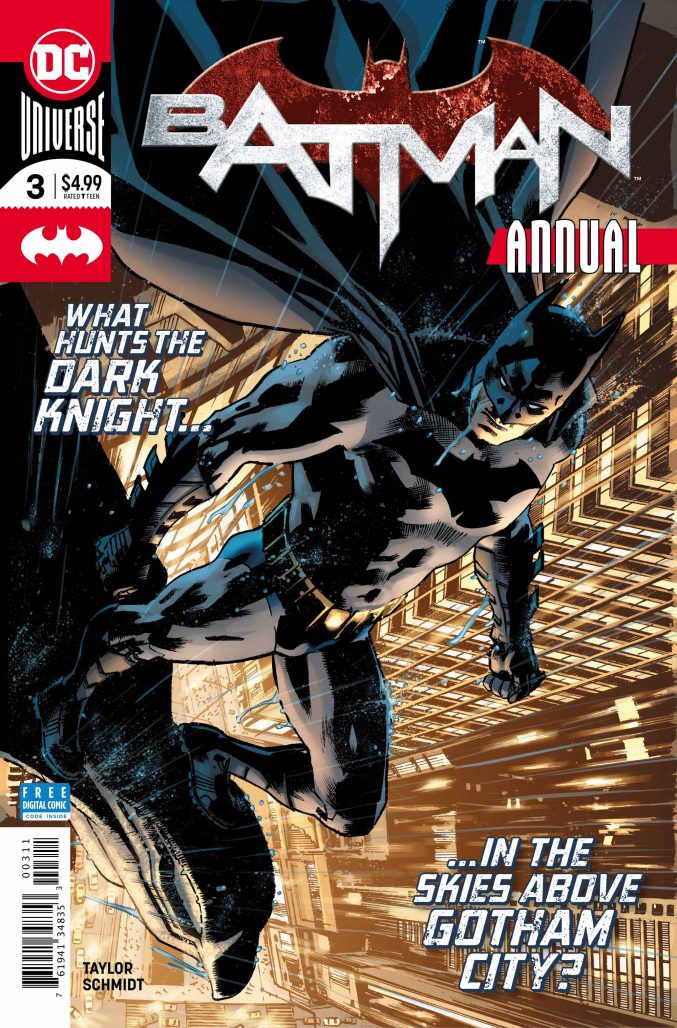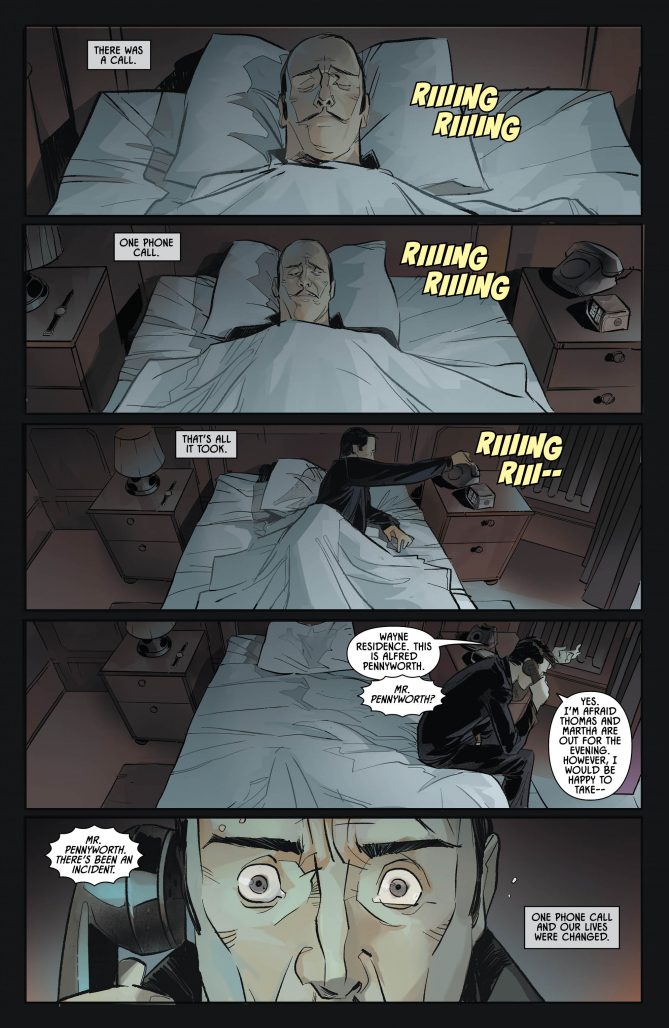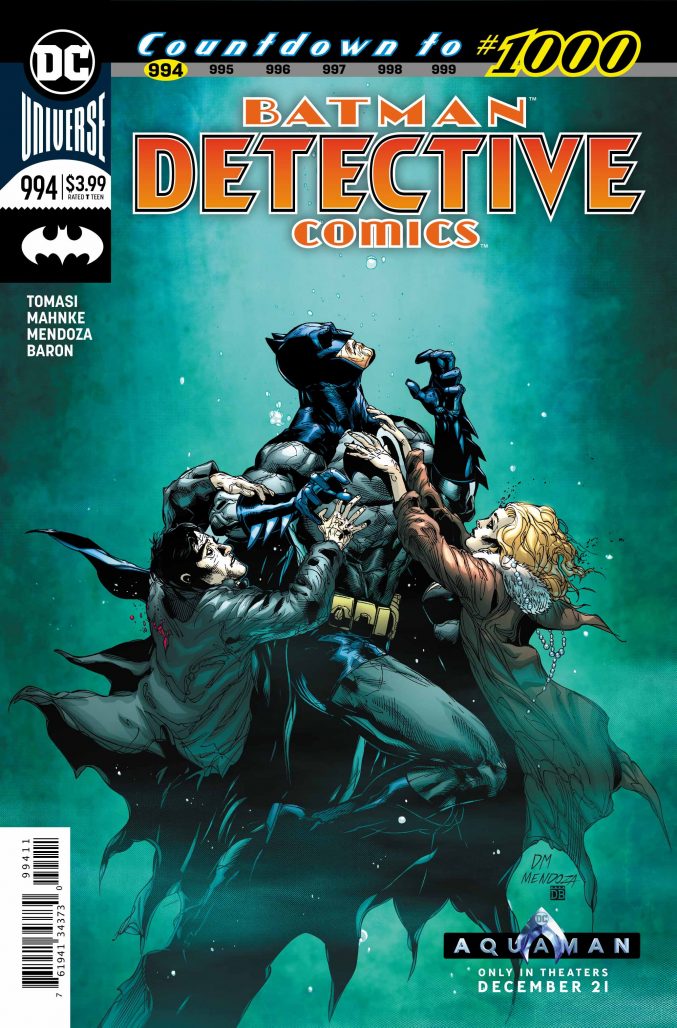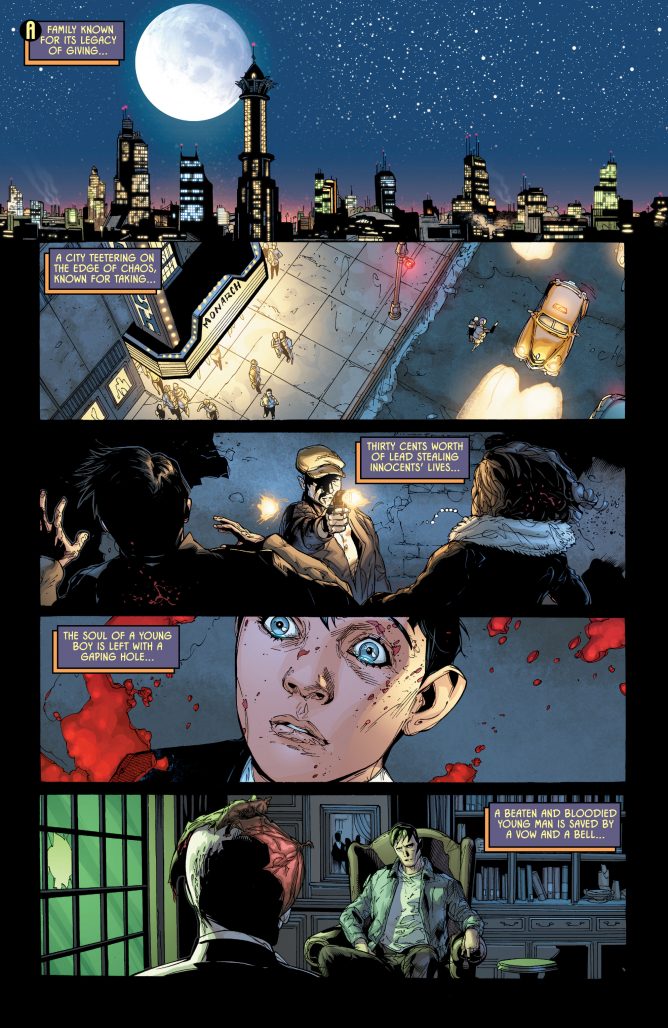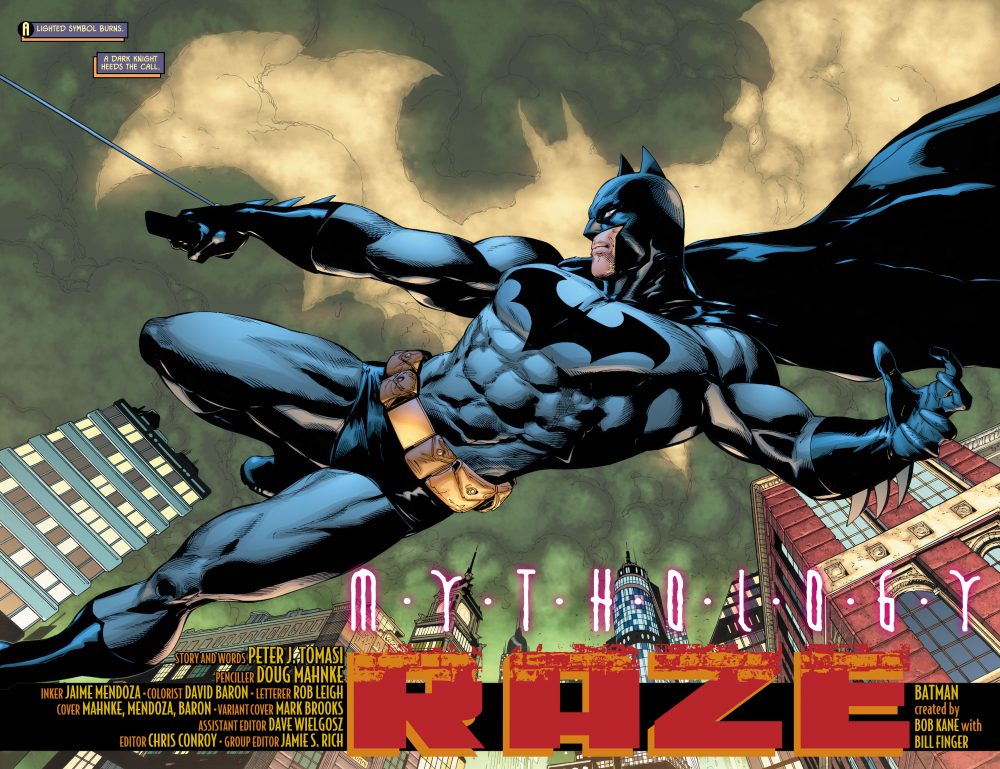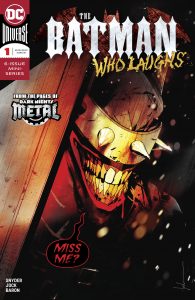DC Comics is trying something new. In the wake of their Rebirth initiative, the publisher has rapidly expanded its content to include diverse new imprints such as Young Animal, Wildstorm, Wonder Comics, Black Label, Ink, and Zoom. As their lineup expands, it can be hard to figure out what to pick up each week. That’s what our team is here to help with, every Wednesday, with the DC Round-Up!
THIS WEEK: How many Batman comics are too many Batman comics? Kidding! You can never have too many Batman comics.
Note: the reviews below contain spoilers. If you want a quick, spoiler-free buy/pass recommendation on the comics in question, check out the bottom of the article for our final verdict.
 Batman Annual #3
Batman Annual #3
Writer: Tom Taylor
Artist: Otto Schmidt
Letterer: A Larger World’s Troy Peteri
Last week’s Batman #60 ended with Bruce Wayne’s father from the Flashpoint timeline—who became Batman after being the lone survivor of that fateful night in his own reality—looming over main continuity Bruce and an injured Alfred. It was a twist telegraphed by the last panel of the Batman #50 non-wedding issue way back in July, which showed Flashpoint Batman among a cadre of villains in Arkham Asylum, seemingly aligned with Bane, helping to “break the bat.” In other words, Flashpoint Batman showing up is not likely to make for a happy reunion in Batman #61.
None of that, however, factors into this week’s Batman Annual #3, at least not directly. That thread will likely get picked up again next week once regular writer Tom King returns to this series. This week we have the other superhero Tom doing writing duties, Tom Taylor (Injustice, X-Men: Red), telling a standalone Bat-story that’s largely self-contained and set in the past. The ending to Batman #60 matters, insofar as it sets a thematic tone for this story. This is, simply put, a tangential riff about what fatherhood means in the Batman mythos, told through the perspective of Bruce Wayne’s surrogate father, Alfred Pennyworth.
And we’ll get to that (and why it works so well) in a moment. I want to first talk about Tom Taylor, probably the best superhero writer still relatively under the radar. Taylor has worked on video game tie-ins like Injustice for DC plus the third X-Men and fourth Spider-Man comics for Marvel. I like Taylor for a couple reasons. No. 1, the guy does thankless work with obvious talent and energy, even on projects guaranteed to be unnoticed (anyone who has ever worked in an office in any capacity can relate to that), and No. 2, Taylor scripts comics built upon ideas relevant to our times. In this issue, he creates a new Bat-villain, The Drone, an embittered former drone operator hunting those responsible for sucking him into the military-industrial complex. That’s great, but a lot of superhero writers tell stories blatantly culled from the headlines. What makes Taylor’s special is his solid narrative structure, plus an ample smattering of heart.
Let’s take a deep dive into the first three pages of this comic. See, the vast majority of Tom Taylor comics function the same way: orient the reader quickly by giving lead characters clear conflicts and desires. This comic does that by page two. It opens with Alfred in bed, getting the call that Thomas and Martha Wayne were shot. Conflict. As he dresses in a panic, the narration lets us know what Alfred wants, and it’s certainly not to be the only family for a newly-orphaned boy. Alfred tells us he had plans, plans that seemed important, plans that involved leaving the Waynes. Desires. And there are few things in fiction more compelling than a character’s sense of duty putting them in conflict with their desires, which we quickly learn has been the case for loyal Alfred all these years.
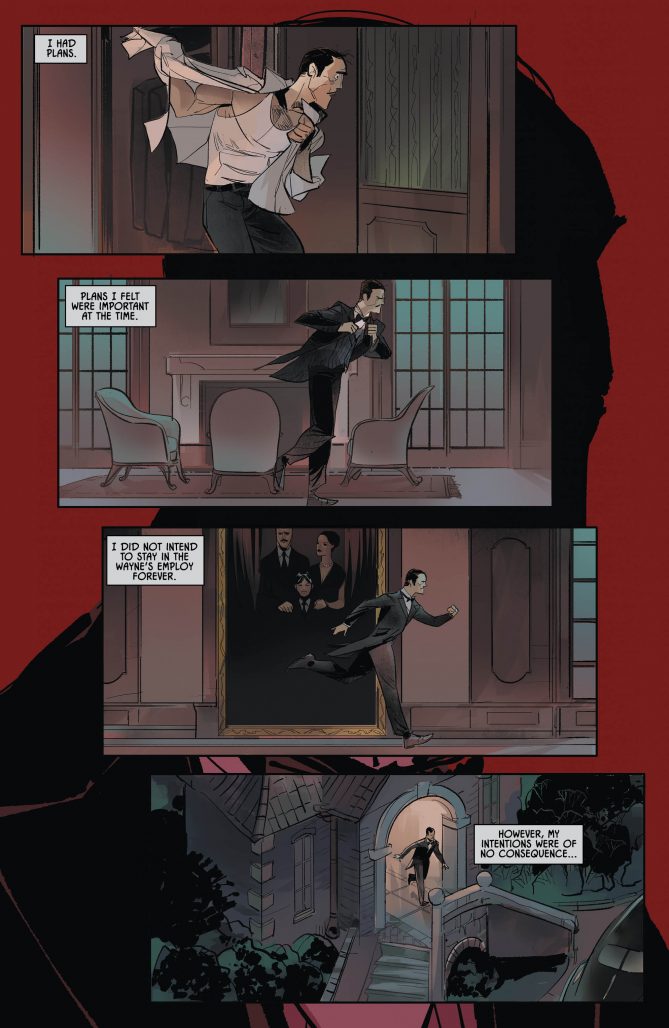
It’s also page three (below) that the vast contributions of artist Otto Schmidt (Green Arrow, Nightwing Annual) are on full display. That page features a nigh-perfect layout, one that expertly guides the reader’s gaze from Alfred arriving, to Alfred gravely dealing with police, to the crushing image of Bruce. That third and final panel is wordless, just a young boy who will be Batman standing in the rain, eyes wide and face bewildered. He’s swallowed by a man’s raincoat, likely loaned to him by a detective, outsized in a way that stresses the character’s lost innocence. Oof. These first three pages are just straight-up good comics. And from there we’re off.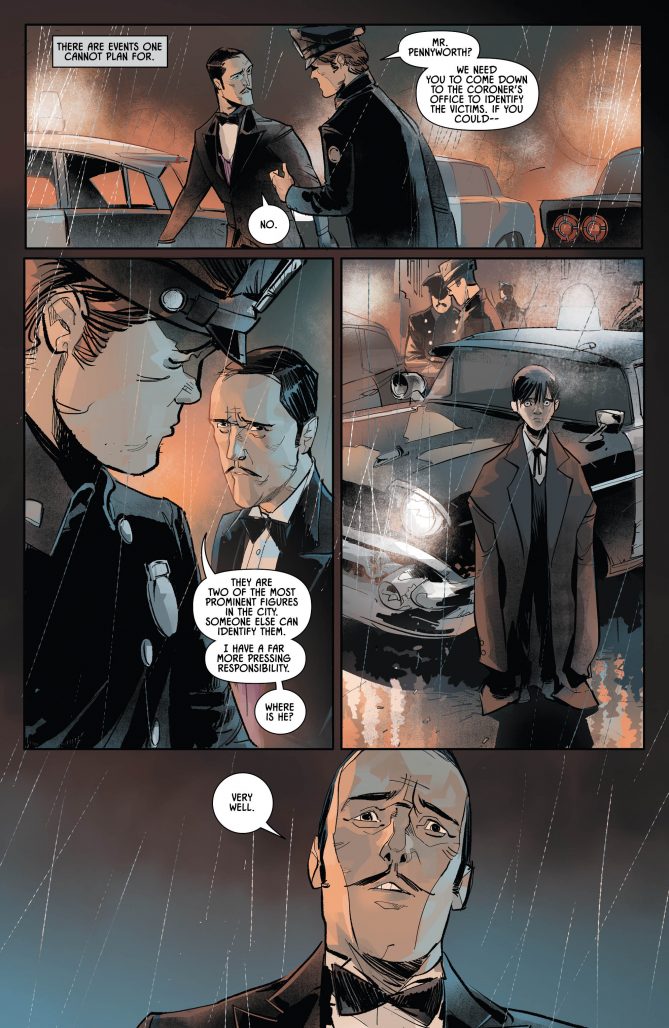
Thompkins attends to Bruce and turns to Alfred, who refuses her help. It’s now that Thompkins points out Bruce and Alfred are alike, stoic and stubborn and obsessive about their chosen duties to the point of self-destruction. Batman is an old character with a long history, and I’m sure this has all been explored in the past. Little in Gotham City hasn’t, but I’d never read such a poetic suggestion that Alfred’s example had shaped Bruce’s own dedication to his work. So, when Thompkins tells Alfred, “It’s no surprise he takes after you. That’s what happens when you raise a child.” I lost it.
The story ends with a saccharine scene: Bruce tending to Alfred (he always burns the crumpets!). More importantly, though, it reminds us in as engaging a way as possible that regardless of the villainous father from another timeline plot destined to unfold soon, Alfred is Bruce’s real dad. Now can someone get Taylor and Schmidt the flagship title for a prominent character? How about Nightwing, or wait, even better, Green Arrow? Please.
Verdict: Buy It
 Detective Comics #994
Detective Comics #994
Writer: Peter J. Tomasi
Artist: Doug Mahnke
Inker: Jaime Mendoza
Colorist: David Baron
Phew. That was a whole lot of Batman, so I’ll keep discussion of this second notable Batman title a little more brief. In Detective Comics #994, we have a new creative team—Peter J. Tomasi and Doug Mahnke—and the start of the countdown to this spring’s Detective Comics #1000. There’s always pressure on creators taking over a flagship character. I have to imagine that pressure is all the more intense when said character is Batman on the eve of such a milestone.
Tomasi and Mahnke certainly open their run in ambitious fashion. Remember when Grant Morrison and Frank Quitely started their character-defining All-Star Superman with a rapid-fire one page origin re-telling? Well, that’s what Tomasi and Mahnke also do here. It mostly works, too. Any inability to match is less on the creators and more on Batman’s origin not quite being as neat.
The origin re-telling makes a nice mission statement, essentially telling readers that while Tom King is doing his boundary-testing 104-issue humanization arc over in Batman, Detective Comics will take the traditional approach. The rest of the issue then goes on to make that even clearer, doing so by starting a perplexing murder mystery—someone seems to have modified two dead bodies to look like Bruce’s parents—before segueing into some fisticuffs with a grotesque monster of a villain that breathes Joker gas.
In other words, all the basic ingredients are in this one: origin, mystery, new scary villain, The Joker. I remember thinking when Tomasi and Mahnke were announced as the new creative team for this title back in July that DC had made a safe choice. Well, that makes sense: this book is the safer of the two titles. One issue in, that doesn’t seem like a bad thing.
Verdict: Buy
Round-Up
The Batman Who Laughs #1 packs a mess of plot twists. This first issue is a mindscrew, perhaps deliberately, making it tough to evaluate without seeing more of what the creators are up to. Fans of the Joker-Batman dynamic, however, will love every panel. Also, I can’t shake that there are three Jokers out there, and I hope this story addresses that.
- Batman: Damned #2 is back (sans Bat-penis). This issue re-imagines Etrigan the Demon as a grindcore rapper, which is…something. It didn’t connect with me, but I felt that way about the first installment too…until I read the oversized glossy format. My tablet doesn’t do the intricate Lee Bermejo artwork justice; I may change my mind later.
- And now, finally, non-Batman comics! Shuffling Kyle Rayner into Titans with
NightwingRic Grayson indisposed is cool, making this the most varied iteration of the team in a good while. - With seven consecutive issues of super-accessible fast-paced adventuring, Robert Venditti and Bryan Hitch’s Hawkman is my favorite DC surprise of the year. I like both of these creators, but I don’t think anyone expected their collaboration to be this good.
- The runner-up would be Steve Orlando and Travel Foreman’s Electric Warriors, which just hasn’t had as many issues. Through two, this book has psychedelic art, a tense and timely story, and a setting in an odd part of the DC timeline—checking most of my boxes.
- Brian Bendis and Ivan Reis’ Superman #6, like Action Comics, is still very very good.
Miss any of our earlier reviews? Check out our full archive!


